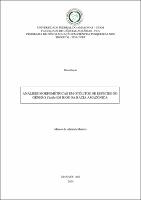| ???jsp.display-item.social.title??? |


|
Please use this identifier to cite or link to this item:
https://tede.ufam.edu.br/handle/tede/7958| ???metadata.dc.type???: | Dissertação |
| Title: | Análises morfométricas em otólitos de espécies do gênero Cichla em rios da bacia Amazônica |
| Other Titles: | Morphometric analysis in otolith of species of the genus Cichla in Amazon basin rivers |
| ???metadata.dc.creator???: | Mereles, Marcos de Almeida  |
| ???metadata.dc.contributor.advisor1???: | Freitas, Carlos Edwar de Carvalho |
| First advisor-co: | Sousa, Raniere Garcez Costa |
| ???metadata.dc.contributor.referee1???: | Souza, Flávia Kelly Siqueira de |
| ???metadata.dc.contributor.referee2???: | Pouilly, Marc |
| ???metadata.dc.contributor.referee3???: | Amadio, Sidineia Aparecida |
| ???metadata.dc.description.resumo???: | Com a finalidade de aumentar o arcabouço de técnicas que possibilitam o avanço sobre o conhecimento dos parâmetros populacionais das espécies de peixes, o presente estudo utilizou duas abordagens morfométricas empregando técnicas tradicionais (medidas lineares) e geométricas (forma), sobre as espécies do gênero Cichla, com o objetivo de estabelecer relações morfométricas entre o corpo e o otólito, e distinguir espécies e populações através da forma do otólito sagitta. Para isso, foram amostrados os otólitos sagittae das espécies Cichla temensis, C. orinocensis e C. monoculus, coletadas em três rios (rio Negro, rio Uatumã e rio Jatapú) pertencentes à bacia Amazônica. A partir do uso das medidas lineares foram estabelecidas relações entre o corpo e o otólito da espécie Cichla temensis. Os modelos de regressão linear para o peso e o comprimento dos otólitos em relação as mesmas dimensões corporais do peixe mostraram fortes correlações, principalmente para a variável peso com um r2 = 0,92, enquanto o comprimento teve um r2 = 0,77. Indicando assim que as dimensões dos otólitos podem ser usadas para estimar o tamanho dos indivíduos da espécie estudada, podendo ser adaptadas também para outras espécies de peixe. Quando avaliado a forma dos otólitos sagittae para discriminar espécies e populações de Cichla, foram verificadas diferenças entre ambos os grupos. Dentre o grupo das espécies, a forma do otólito sagitta do C. temensis mostrou ser completamente diferente das espécies C. monoculus e C. orinocensis. Enquanto no grupo das populações de C. temensis, os indivíduos dos rios Negro e Jatapú mostram-se diferentes independe dos métodos utilizados para descrever a forma dos otólitos. As diferenças encontradas na forma do otólito no grupo das espécies podem estar relacionadas diretamente com fatores genéticos, enquanto que a morfologia dos otólitos das populações podem estar sobre influencias das variações ambientais. Esses resultados confirmam a capacidade de diferenciações de espécies e populações através da morfologia dos otólitos, no entanto, são necessários mais estudos para verificar o papel do efeito genético em comparação aos efeitos ambientais e bióticos para esclarecer as diferenças observadas nos otólitos. |
| Abstract: | In order to increase the framework of techniques that make it possible to advance the knowledge of the population parameters of fish species, the present study used two morphometric approaches employing traditional techniques (linear measurements) and geometric, on Cichla species, with the objective of establishing morphometric relationships between the body and the otolith, and distinguishing species and populations through the shape of the sagitta otolith. For this, the sagittae otoliths of the species Cichla temensis, C. orinocensis and C. monoculus were sampled, collected in three rivers (Negro river, Uatumã river and Jatapú river) belonging to the Amazon basin. Using linear measurements, relationships were established between the body and the otolith of the species Cichla temensis. The linear regression models for the weight and length of the otoliths in relation to the same body dimensions of the fish showed strong correlations, mainly for the variable weight with an r2 = 0.92, while the length had an r2 = 0.77. Thus indicating that the dimensions of the otoliths can be used to estimate the size of the individuals of the species studied, and can also be adapted for other fish species. When assessing the shape of the sagittae otoliths to discriminate Cichla species and populations, differences were found between both groups. Among the group of species, the shape of the C. temensis sagitta otolith proved to be completely different from the species C. monoculus and C. orinocensis. While in the group of C. temensis populations, individuals from the Negro and Jatapú rivers are different regardless of the methods used to describe the shape of the otoliths. The differences found in the shape of the otolith in the group of species can be directly related to genetic factors, while the morphology of the otoliths of the populations can be influenced by environmental variations. These results confirm the ability to differentiate species and populations through the morphology of the otoliths, however, further studies are needed to verify the role of the genetic effect in comparison to the environmental and biotic effects to clarify the differences observed in the otoliths. |
| Keywords: | Tucunaré (Peixe) Espécies Morfometria Otólitos sagittae Peixes - Pesquisa |
| ???metadata.dc.subject.cnpq???: | CIÊNCIAS AGRÁRIAS: RECURSOS PESQUEIROS E ENGENHARIA DE PESCA |
| ???metadata.dc.subject.user???: | Espécies Morfometria Otólito Populações Tucunaré |
| Language: | por |
| ???metadata.dc.publisher.country???: | Brasil |
| Publisher: | Universidade Federal do Amazonas |
| ???metadata.dc.publisher.initials???: | UFAM |
| ???metadata.dc.publisher.department???: | Faculdade de Ciências Agrárias |
| ???metadata.dc.publisher.program???: | Programa de Pós-graduação em Ciências Pesqueiras nos Trópicos |
| Citation: | MERELES, Marcos de Almeida. Análises morfométricas em otólitos de espécies do gênero Cichla em rios da bacia Amazônica. 2020. 49 f. Dissertação (Mestrado em Ciências Pesqueiras nos Trópicos) - Universidade Federal do Amazonas, Manaus, 2020. |
| ???metadata.dc.rights???: | Acesso Aberto |
| ???metadata.dc.rights.uri???: | http://creativecommons.org/licenses/by-nd/4.0/ |
| URI: | https://tede.ufam.edu.br/handle/tede/7958 |
| Issue Date: | 28-Aug-2020 |
| Appears in Collections: | Mestrado em Ciências Pesqueiras nos Trópicos |
Files in This Item:
| File | Description | Size | Format | |
|---|---|---|---|---|
| Dissertação_MarcosMereles_PPGCIPET.pdf | Dissertação_MarcosMereles_PPGCIPET | 1.44 MB | Adobe PDF |  Download/Open Preview |
Items in DSpace are protected by copyright, with all rights reserved, unless otherwise indicated.




